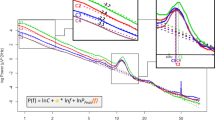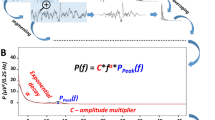Abstract
Objective
The purpose of the present study was to analyse gender- and age-specific variations in microstructures of rapid eye movement (REM) sleep and to provide reference values for microstructures.
Methods
The results are based on Somnolyzer 24 × 7 (The Siesta Group Schlafanalyse GmbH., Vienna, Austria) evaluation of data from the SIESTA database. Data from 160 healthy subjects (74 men and 86 women; age range 20–95 years) were considered and a total of 11 REM sleep-related variables analysed.
Results
Some of the variables, i.e., REM and slow eye movement (SEM) density, SEM intensity and the REM sleep arousal index, are fairly constant across ages and do not differ between men and women. The atonia index shows gender-specific differences, but does not vary with age among healthy subjects; whereas REM intensity and the time in tonic REM sleep decrease with age, without differences between men and women. Time in stage R sleep (minutes and percentage of total sleep time, TST) and the time in phasic stage R sleep vary with both age and gender.
Conclusion
Given the relevance of sleep microstructures in research and potentially also in clinical studies, there is a need for reference values indicating the range of variation of these variables in healthy subjects. Reference values always have the limitation that they refer to the specific method of assessment. Where different detection algorithms are used, the reference values might vary. The reference values presented here—where necessary for men and women separately and/or stratified by age—refer to microstructures assessed by the feature extraction module of the Somnolyzer 24 × 7.
Zusammenfassung
Fragestellung
Ziel der vorliegenden Studie war es, Variationen in REM-Mikrostrukturen in Abhängigkeit von Alter und Geschlecht zu untersuchen und Referenzwerte für Mikrostrukturen anzugeben.
Methoden
Die Ergebnisse basieren auf der Somnolyzer 24 × 7 Auswertung der Daten aus der Siesta-Datenbank von 160 gesunden Personen (74 Männer und 86 Frauen) im Alter von 20 bis 95 Jahren. Insgesamt wurden 11 REM-Schlaf-bezogene Variablen ausgewertet.
Ergebnisse
Einige der untersuchten Variablen (REM- und SEM-Dichte, SEM-Intensität sowie der Arousal-Index im REM-Schlaf) variieren weder nennenswert mit dem Alter noch unterscheiden sie sich zwischen Männern und Frauen. Der Atonie-Index lässt Geschlechtsunterschiede erkennen, variiert aber nicht mit dem Alter bei gesunden Personen. Die REM-Intensität sowie die Zeit im tonischen REM-Schlaf nehmen mit dem Alter ab, zeigen jedoch keine Geschlechtsunterschiede. Die im REM-Schlaf verbrachte Zeit (min und % TST) sowie die Zeit im phasischen REM-Schlaf variieren sowohl mit dem Alter als auch zwischen Männern und Frauen.
Schlussfolgerung
Aus der Relevanz von Mikrostrukturen des REM-Schlafs in Forschungszusammenhängen sowie möglicherweise in klinischen Studien lässt sich ein Bedarf an Referenzwerten für gesunde Personen ableiten. Referenzwerte haben stets als Limitation, dass sie nur für eine spezifische Methode gelten. Wenn unterschiedliche Algorithmen zur Detektion verwendet werden, können Referenzwerte variieren. Die hier präsentierten Referenzwerte – wenn nötig getrennt für Männer und Frauen sowie stratifiziert nach dem Alter – gelten für Mikrostrukturen, die mit dem „Feature Extraction Module“ des Somnolyzer 24 × 7 ausgewertet wurden.

Similar content being viewed by others
References
American Academy of Sleep Medicine (2014) International classification of sleep disorders, 3 edn. (ICSD-3). American Academy of Sleep Medicine, Darien
American Psychiatric Association (2013) Diagnostic and statistical manual of mental disorders, 5 ed. (DMS-5), American Psychiatric Association, Arlington
Anderer P, Gruber G, Parapatics S et al (2005) An E-health solution for automatic sleep classification according to Recvhtschaffen and Kales: validation study of the Somnolyzer 24 × 7 utilizing the Siesta database. Neuropsychobiology 51:115–133
Anderer P, Saletu B, Saletu-Zyhlarz GM et al (2006) Electrophysiological Evaluation of sleep. (2006). In: Kinoshita T (ed) Textbook for the training course of the International Pharmaco-EEG Society. The Awaji Island of Hyogo Prefecture, Japan, pp 107–129
Anderer P, Moreau A, Woertz M et al (2010) Computer-assisted sleep classification according to the standard of the American Academy of Sleep Medicine: valiadation study of the AASM version of the Somnolyzer 24 × 7. Neuropsychobiology 62:250–264
Anderer P I-9.1.8 Augenbewegungen (2011) In: DGSM – Schulz –Geisler – Rodenbeck (HRSG) Kompendium Schlafmedizin ecomed 18. Erg. Lfg. 11/11
Arfken CL, Joseph A, Sandhu GR et al (2014) The status of sleep abnormalities as a diagnostic test for major depressive disorder. J Affect Disord 156:36–45
Boselli M, Parrino L, Smerieri A, Terzano MG (1998) Effect of age on EEG arousals in normal sleep. Sleep 21:361–367
Carskadon MA, Dement WC (2011) Normal human sleep—an overview. In: Kryger MH, Roth T, Dement WC (eds) Principles and practice of sleep medicine. pp 16–26
Cohrs S (2008) Sleep disturbances in patients with schizophrenia. CNS Drugs 22:939–962
Cona F, Pizza F, Provini F, Magosso E (2014) An improved algorithm for the automatic detection and characterization of slow eye movements. Med Eng Phys 36:954–961
Danker-Hopfe H, Schäfer T, Dorn H et al (2005) Percentile reference charts for selected sleep parameters for 20- to 80-year old healthy subjects from the SIESTA database. Somnologie 9:3–14
Danker-Hopfe H, Kunz D, Gruber G et al (2004) Interrater reliability between scorers from eight European sleep laboratories in subjects with different sleep disorders. J Sleep Res 13:63–69
Danker-Hopfe H, Anderer P, Zeitlhofer J et al (2009) Interrater reliability for sleep scoring according to the Rechtschaffen & Kales and the new AASM standard. J Sleep Res 18:74–84
Dorffner G, Vitr M, Anderer P (2014) The effects of aging on normal sleep architecture in healthy subjects. Advances in experimental medicine and biology. Springer (in press)
Ehlers CL, Kupfer DJ (1997) Slow-wave sleep: do young adult men and women age differently? J Sleep Res 6:211–215
Ermis U, Krakow K, Voss U (2010) Arousal threshold during tonic and phasic REM sleep. J Sleep Res 19:400–406
Ferri R, Rundo F, Manconi M et al (2010) Improved computation of the atonia index in normal controls and patients woith REM sleep behaviour disorder. Sleep Med 11:947–949
Ferri R, Bruni O, Fulda S et al (2012) A quantitative analysis of the submentalis muscle electromyographic amplitude during rapid eye movement sleep across the lifespan. J Sleep Res 21:257–263
Ferri R, Gagnon JF, Postuma RB et al (2014) Comparison between an automatic and a visual scoring method of the chin muscle tone during rapid eye movement sleep. Sleep Med 15:661–665
Frauscher B, Iranzo A, Gaig C et al (2012) Normative EMG values during REM sleep for the diagnosis of REM sleep behaviour disorder. Sleep 35:835–845
Frauscher B, Ehrmann L, Mitterling T et al (2013) Delayed diagnosis, range of severity, and multiple sleep comorbidities: a clinical and polysomnographic analysis of 100 patients of the Innsbruck narcolepsy cohort. J Clin Sleep Med 9:805–812
Frauscher B, Ehrmann L, Högl B (2013) Defining muscle activities for assessment of rapid eye movement sleep behaviour disorder. From a qualitative to a quantitative diagnostic level. Sleep Med 14:729–733
Frauscher B, Gabelia D, Mitterling T et al (2014) Motor events during healthy sleep: a quantitative polysomnographic study. Sleep 37:763–773
Frauscher B, Gabelia D, Biermayr M et al (2014) Validation of an integrated software for the detection of rapid eye movements sleep behaviour disorder. Sleep 37:1663–1671
Iber C, Ancoli-Israel S, Chesson AL et al (2007) The AASM manual for the scoring of sleep and associated events. Rules, terminology and technical specifications, 1 ed. American Academy of Sleep Medicine, Westchester
Khalil A, Wright MA, Walker MC, Eriksson SH (2013) Loss of rapid eye movement sleep atonia in patients with REM sleep behavioural disorder, narcolepsy, and isolated loss of atonia. J Clin Sleep Med 9:1039–1048
Klösch G, Kemp B, Penzel T et al (2001) The SIESTA project polygraphic and clinical database. A new approach to studying subjective and objective measurements of human sleep. IEEE Eng Med Biol 20:51–57
Kobayashi I, Boarts JM, Delahanty DL (2007) Polysomnographically measured sleep abnormalities in PTSD: a meta-analytic review. Psychophysiology 44:660–669
McCarter SJ, St Louis EK, Boeve BF (2012) REM sleep behaviour disorder and REM sleep without atonia as an early manifestation of degenerative neurological disease. Curr Neurol Neurosci Rep 12:182–192
Moser D, Anderer P, Gruber G et al (2009) Sleep classification according to AASM and Recvhtscvhaffen & Kales: effect on sleep scoring parameters. Sleep 32:139–149
Moraes W, Piovezan R, Poyares D et al (2014) Effects of aging on sleep structure throughout adulthood: a population based study. Sleep Med 15:401–409
Ohayon MM, Carskadon MA, Guilleminault C, Vitiello MV (2004) Meta-analysis of quantitative sleep parameters from childhood to old age in healthy individuals: developing normative values across the human life span. Sleep 27:1255–1273
Palagini L, Baglioni C, Ciapparelli A et al (2013) REM sleep dysregulation in depression: state of the art. Sleep Med Rev 17:377–390
Penzel T, Kemp B, Klösch G et al (2001) Axquisition of biomedical signals databases. IEEE Eng Med Biol 20:25–32
Peters KR, Ray LB, Fogel S et al (2014) Age differences in the variability and distribution of sleep spindle ab rapid eye movement densities. PLoS One 9(3) e91047
Pillai V, Kalmbach DA, Ciesla JA (2011) A meta-analysis of electroencephalographic sleep in depression: evidence for genetic biomarkers. Biol Psychiatry 70:912–919
Pillar G, Malhotra A, Lavie P (2000) Post-traumatic stress disorder and sleep—what a nightmare. Sleep Med Rev 4:183–200
Pizza F, Fabbri M, Magosso E et al (2011) Slow eye movements during nocturnal sleep. Clin Neurophys 122:1556–1561
Postuma RB, Gagnon JF, Rompré S, Montplaisir JY (2010) Severity of REM atonia loss in idiopathic REM sleep behaviour disorder predicts Parkinson disease. Neurology 74:239–244
Rechtschaffen A, Kales A (1968) A manual of standardized terminology techniques and scoring systems for sleep stages of human subjects. U.S. Government Printing Office, Washington DC
Rodenbeck A, Binder R, Geisler P et al (2006) A review of sleep EEG patterns. Part I: a compilation of amended rules for their visual recognition according to Rechtschaffen and Kales. Somnologie 10:159–175
Rodenbeck A, Danker-Hopfe H, Geisler P et al (2015) Ergänzende Regeln zu Frequenzen und Graphoelementen der Schlafstadienanalyse – Update 2014. Somnologie in diesem Heft
Sasai-Sakuma T, Frauscher B, Mitterling T et al (2014) Quantitative assessment of isolated rapid eye movement disorder: clinical and research omplications. Sleep Med 15:1009–1015
Schredl M, Paul F, Reinhard I et al (2012) Sleep and dreaming on patients with borderline personality disorder: a polysomnographic study. Psychiatry Res 200:430–436
Steiger A, Kimura M (2010) Wake and sleep EEG provide biomarkers in depression. J Psychiatr Res 44:242–252
Voderholzer U, Riemann D, Huwig-Poppe C et al (2007) Sleep in obsessive compulsive disorder: polysomnographic studies under baseline conditions and after experimentally induced serotonin deficiency. Eur Arch Psychiatry Clin Neurosci 257:173–182
Wichniak A, Wierzbicka A, Jernajczyk W (2013) Sleep as biomarker for depression. Int Rev Psycgiatry 25:632–645
Yang C, Winkelman JW (2006) Clinical significance of sleep EEG abnormalities in chronic schizophrenia. Schizophr Res 82:251–260
Compliance with ethical guidelines
Conflict of interest. Until May 2013, H. Danker-Hopfe was shareholder and chairmen of the supervisory board of the Siesta Group Schlafanalyse GmbH. G. Dorffner is a part-time employee of the Siesta Group Schlafanalyse GmbH., and was managing director from 2002 until early 2014. Since November 2002, G. Gruber has been an employee of the Siesta Group Schlafanalyse GmbH. P. Anderer is a freelancer at the Siesta Group Schlafanalyse GmbH., and a part-time employee of the Philips Austria GmbH. E. Olbert states that there are no conflicts of interest.
All studies on humans described in the present manuscript were carried out with the approval of the responsible ethics committee and in accordance with national law and the Helsinki Declaration of 1975 (in its current, revised form). Informed consent was obtained from all patients included in studies.
Author information
Authors and Affiliations
Corresponding author
Rights and permissions
About this article
Cite this article
Danker-Hopfe, H., Gruber, G., Olbert, E. et al. Variations in microstructures of REM sleep. Somnologie 19, 12–21 (2015). https://doi.org/10.1007/s11818-015-0700-6
Received:
Accepted:
Published:
Issue Date:
DOI: https://doi.org/10.1007/s11818-015-0700-6




